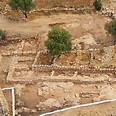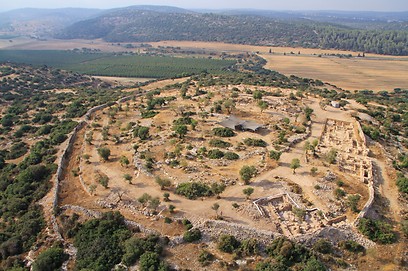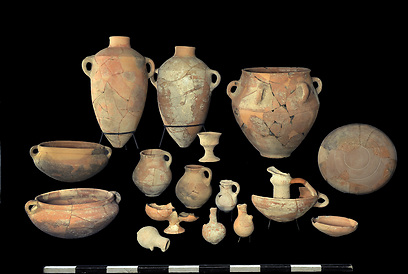
One of the buildings is identified by the researchers – Prof. Yossi Garfinkel of the Hebrew University and Sa'ar Ganor of the Israel Antiquities Authority – as David’s palace, and the other structure served as an enormous royal storeroom.
"The wall enclosing the palace is about 30 meters (100 feet) long, and an impressive entrance is fixed it through which one descended to the southern gate of the city, opposite the Valley of Elah. Around the palace’s perimeter were rooms in which various installations were found – evidence of a metal industry, special pottery vessels and fragments of alabaster vessels that were imported from Egypt.

Aerial picture of site (Photo: Sky View, courtesy of Hebrew University and Israel Antiquities Authority)
"The palace is located in the center of the site and controls all of the houses lower than it in the city. From here one has an excellent vantage looking out into the distance, from as far as the Mediterranean Sea in the west to the Hebron Mountains and Jerusalem in the east. This is an ideal location from which to send messages by means of fire signals. Unfortunately, much of this palace was destroyed 1,400 years later when a fortified farmhouse was built there in the Byzantine period."
A pillared building about 15 meters (49 feet) long by 6 meters (20 feet) wide was exposed in the north of the city, which was used as an administrative storeroom.
According to the researchers, “It was in this building the kingdom stored taxes it received in the form of agricultural produce collected from the residents of the different villages in the Judean Shephelah. Hundreds of large store jars were found at the site whose handles were stamped with an official seal as was customary in the Kingdom of Judah for centuries."

Finds from site (Photo: Clara Amit, courtesy of Israel Antiquities Authority)
The palace and storerooms are evidence of state sponsored construction and an administrative organization during King David’s reign.
“This is unequivocal evidence of a kingdom’s existence, which knew to establish administrative centers at strategic points”, the archaeologists say. “To date no palaces have been found that can clearly be ascribed to the early tenth century BCE as we can do now. Khirbet Qeiyafa was probably destroyed in one of the battles that were fought against the Philistines circa 980 BCE.
"The palace that is now being revealed and the fortified city that was uncovered in recent years are another tier in understanding the beginning of the Kingdom of Judah."
The exposure of the biblical city at Khirbet Qeiyafa and the importance of the finds discovered there have led the Israel Antiquities Authority to act together with the Nature and Parks Authority and the planning agencies to cancel the intended construction of a new neighborhood nearby and to promote declaring the area around the site a national park.
This plan stems from the belief that the site will quickly become a place that will attract large numbers of visitors who will be greatly interested in it, and from it one will be able to learn about the culture of the country at the time of King David.















